Native Writing Systems of Africa
By 'Alik Shahadah + Other:-
Ancient Africa had a predominately, but not exclusively, oral tradition. But Ethiopia for over a 1000 of years has used, and still uses a Ge'ez based native script.
And apart from Ajami (Arabic script for African languages), West Africa had Vai and Nsibidi. Not to mention the obvious Nile-Valley (Ancient Egyptian and Nubian) scripts at the beginning of civilization.
SCRIPTS ARE CULTURE
A script is not only a
technology for writing the spoken word, It is also a cultural symbol of a
people and their identity. The mere sign of Arabic script carries the
power of Islam and the Arab/Muslim people. Every time we see Amharic
written we see the might of Ethiopian culture. A script is powerful
political symbol used all over the world to show national identity. It
is not accidental that Hebrew was reinstated, from obsoleteness, when
Israel was created in 1948.
Fact: It
was once thought that the origin of Egyptian Hieroglyphs are religious
and historical, but recent developments could point to an economical
impetus for this script (just like Sumerian script) as well as push back
the time depth of this writing system
Tifinaɣ (a Berber script) used by some Berber peoples, notably the Tuareg,
to write their languages. A modern derivate of the traditional script,
known as Neo-Tifinagh, was introduced in the 20th century. Despite
limited usage it often serves to assert a Berber identity politically
and symbolically, as distinct from an Arabized identity.
Not only was Hebrew a fully functional part of unifying Jews, it was also a political symbol of their claim
of a connection to Ancient Israel. There is no doubt the every time we
see Japanese's we see Japanese's culture, every time we see Chinese we
must think in terms of the culture, politics and identity of the
Chinese. And by this same logic every time we see Latin we can almost
map the history of conquered people and the politics of Western
civilization on the world. There is a direct relationship (while not
exclusive) to the presence of Latin and the power of Western imposition.
(Turkey, most of Africa, all of Europe, etc).
Tifinaɣ (a Berber script) used by some Berber peoples, notably the Tuareg,
to write their languages. A modern derivate of the traditional script,
known as Neo-Tifinagh, was introduced in the 20th century. Despite
limited usage it often serves to assert a Berber identity politically
and symbolically, as distinct from an Arabized identity.
Not only was Hebrew a fully functional part of unifying Jews, it was also a political symbol of their claim
of a connection to Ancient Israel. There is no doubt the every time we
see Japanese's we see Japanese's culture, every time we see Chinese we
must think in terms of the culture, politics and identity of the
Chinese. And by this same logic every time we see Latin we can almost
map the history of conquered people and the politics of Western
civilization on the world. There is a direct relationship (while not
exclusive) to the presence of Latin and the power of Western imposition.
(Turkey, most of Africa, all of Europe, etc).
HISTORY OF SCRIPTS
A script is a relatively modern technology for communication [2],
it is a visible mark on a flat surface which carries information. But
not all scripts are equal at representing full speech (syntax, lexicon,
etc). Despite the modern diversity of scripts there are only 4
progenitors (independent development) for every script written today: Egypt (3500 B.C.E.),
Ancient Iraq/Iran (3500 B.C.E.), China, and Mesoamerica. Every other
script is a blueprint of these 4 scripts, or indirectly inspired by them
(diffusion) (e.g. Cherokee).
It was once thought that the
origin of Egyptian Hieroglyphs were religious and historical, but recent
developments could point to an economical impetus for this script as
well as push back the time depth of this writing system.
Europe has never produced any
native script, every script is derivatives—even Ancient Greek. The
history of the alphabet started in ancient Egypt. By the 27th century BC
Egyptian writing had a set of some 24 hieroglyphs which are called
uniliterals. The numerology (0,1,2,3,4,5)
of modern Western scripts all comes from Arabic numerals. We often
believe much of civilization was a European creation, but Europe, like
most of the world, borrowed from the rare genius of four script
inventors, just like it borrowed domestication, and religion.
Cultures which actively use their scripts have a pattern of historical strength and identity.
The most basic form of first scripts were
pictographic. Although a few pictographic or ideographic scripts exist
today, there is no single way to read them, because there is no
one-to-one correspondence between symbol and language. Hieroglyphic were
commonly thought to be ideographic before they were translated, and to
this day Chinese is often erroneously said to be ideographic. In some
cases of ideographic scripts, only the author of a text can read it with
any certainty, and it may be said that they are interpreted rather than
read. True scripts represent the full body of possible speech, they can
completely document the range of ideas spoken. Every thought or idea,
that can be spoken can be written in Amharic, Arabic, English, etc. It
also allows for new words to be written because of the phonetic
representation.
Reading and writing, are not innate for humans, and
it is possible for humans to prefer (when given a chance) alternatives
to scripts. This is why television,☺emotions(pictographic),
are so popular. And with the rise of social media, abbreviations such
as LMAO, prove that script evolution could reverse itself. Also if we
look at words for a long time they become meaningless, because in
reality they are arbitrary, unlike pictograms. Subsequently most of what
we read is not actually reading of the phonemes, but recognized of the
text from previous encounters (we recognize more than we read). This is why unfamiliar words, even if simple, cause us to pause and re-read. (Shahadah - very easy Sha Ha Dah, yet if new and unfamiliar it causes most literate people to slow down or even completely misread). 

In the history of writing
symbols proceeded from ideographic (such as an icon of a bull's head in a
list inventory, denoting that the following numeral refers to head of
cattle) to logographic (an icon of a bull denoting the Semitic word
ʾālep "ox"), to phonetic (the bull's head used as a symbol in rebus
writing, indicating the glottal stop at the beginning of the word for
"ox", namely, the letter aleph).
An orthography is a
standardized system for using a particular writing script to write a
particular language. It includes rules of spelling, and may also concern
other elements of the written language such as punctuation and
capitalization. In the case of Africa special adoptions are needed to
accurately represent every specific African language. In South Africa
the Xhosa languages needs, because it has none of its own, Latin
symbolic representation for the language clicks (!X etc). This is true
for Hausa written in Arabic and Latin based scripts. Because Arabic
historically has no "P" the پ is
created for languages which have that sound, such as Urdu. A language
such as Amharic which is genetically from Ge'ez does not require these
modifications as its is written in its unique script. It is believed
that the changing of letters to suit the language was part of the
process of indigenization that created unique scripts throughout the
world.
* Humans
have been on Earth for 100,000 years bu only in the last 6000 years has
writing been invented, and only in the 20th century has this spread to
majority of the Earth. Yet music has been around for over 42,000 years.
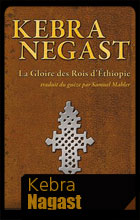 |
Oral tradition accounted for most of Africa, and the world. The high rates of literacy we see today are a unique product of our modern world. Historically, even in literate societies, such as Western Europe, literacy was confided to the elites. Oral traditions have traditionally been considered unsophisticated and totally ridiculed. And while they have some critical developmental potential issues, oral tradition promotes a greater dependency on the usage of memory, story telling and other socially binding traditions. But literate people have far greater neuro-connection between the two half of their brain] and have displayed numerous advantages over non-literate people. [3] Unfortunately oral tradition, beyond this, cannot compete. And in most global encounters it is the societies with scripts than conquer the societies without. |
Very few large nations have
risen without having to rely on scripts. Writing is therefore a
proximate factor in explaining radical disparity between various
societies.
Writing allows bureaucracies,
which allows complex centralized political administrations, economic
exchange, advanced scholarship, accurate history keeping, quick
transmission of information for war and navigation, record keeping, a
repository of traditions can be recorded for eternity with it. The range
at which this information travels, and the frequency in which it can be
reproduced is limitless compared with the oral societies. And this is
why Europe can recount 1000 years of detailed history and learn from it,
yet very little is known about the history of Sub equatorial Africa. So
in oral cultures it only takes 1 missing generation for 1000s of years
of history to be lost to time. Scripts, once deciphered, like Ancient
Egypt, carry a people's memories for eternity.
Some who find reactionary
comfort with romance find this analysis "Eurocentric", but you cannot
seriously build modernity without a written tradition. And it was never a
European invention; as both Sumeria and Ancient Egypt (KMT) were the first to create literate empires and set the tone for civilization. And this is why all the major centers in Ancient Africa, Aksum, KMT, Nubia, Songhai, Mali, Almoravid, etc, had a written tradition. It is part and parcel of complex societies.
See Also | Kebra Negast
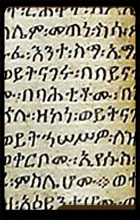 |
Ge'ez script is the only native African script in full usage as at a national and everyday level. Ge'ez (ግዕዝ Gəʿəz), is a script used as an abugida (syllable alphabet) for several languages of Ethiopia and Eritrea but originated in anabjad (consonant-only alphabet) used to write Ge'ez, now the liturgical language of the Ethiopian and Eritrean Orthodox Church. In Amharic and Tigrinya the script is often called fidäl (ፊደል), which means "script" or "alphabet". The Ge'ez script has been adapted to write other, mostly Semitic, languages, such as Amharic in Ethiopia and Tigrinya in Eritrea and Ethiopia. It is also used for Sebatbeit, Me'en, and most other languages of Ethiopia. In Eritrea it is used for Tigre, and it has traditionally been used for Blin, a Cushitic language. |
Tigre, spoken in western
and northern Eritrea , is considered to resemble Ge'ez more so than do
the other derivative languages. Some other languages in the Horn of
Africa, such as Oromo, used to be written using Ge'ez but have migrated to cumbersome Latin-based orthographies.
Ge'ez Syllabary
The earliest inscriptions of
Ethio-Semitic in Ethiopia and Eritrea date to the 9th century BC in
Epigraphic South Arabian (ESA), an Abjad shared with contemporary
kingdoms in South Arabia. After the 7th and 6th centuries BC, however,
variants of the script arose, evolving in the direction of the Ge'ez
abugida (a writing system that is also called an alphasyllabary). This
evolution can be seen most clearly in evidence from inscriptions (mainly
graffiti on rocks and caves) in Tigray region in northern Ethiopia and
the former province of Akkele Guzay in Eritrea. By the first centuries
AD, what is called "Old Ethiopic" or the "Old Ge'ez alphabet" arose, an
abjad (like Arabic and Hebrew with no vowels) written left-to-right (as
opposed to boustrophedon like ESA) with letters basically identical to
the first-order forms of the modern vocalized alphabet (e.g. "k" in the
form of "kä"). In the Ge'ez abugida (or 'fidel'),
the base form of the letter (also known as 'fidel') may be altered. For
example, ሀ hä [hə] (base form), ሁ hu (with a right-side diacritic that
doesn't alter the letter), ሂ hi (with a subdiacritic that compresses the
consonant, so it is the same height), ህ hə [hɨ] or [h] (where the
letter is modified with a kink in the left arm).
OROMO ISSUE
Until the 1970s, Afaan Oromo was written with either the Ge'ez script or
the Latin alphabet Then during the early 1970s, the Oromo Liberation
Front (OLF) chose the Latin alphabet as the official alphabet to write
Afaan Oromo. Between 1974 and 1991 under the Mengistu regime the writing
of Afaan Oromo in any script was forbidden, though limited usage of the
Ge'ez script was allowed. On 3rd November 1991 the OLF convened a
meeting of over 1,000 Oromo intellectuals to decide which alphabet to
use to write Afaan Ormo. After a many hours of debate, they decided
unanimously to adopt the Latin alphabet. Unfortunately many Ormo have
stopped using the indigenous African Ge'ez script after 1991 and began
formally writing Oromoia in a Latin format called called Qubee.
Words are subsequently excessively long to accommodate for the
inadequacies of Latin. It is speculated that the motivation for the
change was to create a distinctive cultural identify from the "semitic"
groups who have historically suppressed their culture. How a European
script could be used over a related African script speaks to the dangers
of so-called liberation when those liberating forces are ignorant of
the broader issues.
See Also | African Kingdoms
Hieroglyphs emerged from the
preliterate artistic traditions of Egypt. For example, symbols on
Gerzean pottery from ca. 4000 BCE resemble hieroglyphic writing. For
many years the earliest known hieroglyphic inscription was the Narmer
Palette, found during excavations at Hierakonpolis (modern Kawm
al-Ahmar) in the 1890s, which has been dated to ca. 3200 BCE. In the
era of the Old Kingdom, the Middle Kingdom and the New Kingdom, about
800 hieroglyphs existed. By the Greco-Roman period, they numbered more
than 5,000.
| Some use to claim that the Ancient Egyptians called themselves Black
based upon KMT (Kemet) which in some circles is translated as "Black
people." Now at the end of the word KMT is an ideogram which can only
mean physical place (the cross road sign above). Black can therefore not be in reference to living beings, only the built environment. |
The word Medu Neter (MDW W
NTR) literally means "tongue of God" or more loosely, "God's words." The
English word, "hieroglyphs," is derived from the Greek word,
"hieroglyphikos," which means "sacred engraving," similar to the basic
meaning of "Medu Neter." This script is an elaborate system of
standardized pictographs that represent both meanings and consonal
sounds. The oldest known evidence for this writing system come from
pre-dynastic pottery at Gerzeh (c. 4000 - 3500 BC; "Gerzean culture"),
which is located about 100 miles south of Ha Ka Ptah (Giza), and from
inscriptions found at Gebel Sheikh Suleiman (Wadi Halfa; 4000 - 3500 BC;
"Nubian A-Group culture") in so-called "Nubia."
The next oldest form of Medu Neter dates between 3300 and 3200 BC and
found in Abdu (tomb of the so-called "Scorpion" suten in Abydos) on clay
tablets that recorded oil and linen deliveries. During the so-called
"dynastic period" (3100 BC - 500 AD), Medu Neter was used on the oldest
of all historical texts, the "Narmer Palette" (3100 BC), then widely
used in the metaphysical/spiritual "Pyramid texts" (2400 - 2200 BC),
coffin texts (2200-2000 BC), and the scientific, spiritual and
administrative papyri (1825-600 BC).
Neter Syllabary
Transliteration
Since vowels were not usually written, two signs could be pronounced in a range of different ways. For example, 
 (ws) could sound like was, wes, ews, awsa, etc. The way that is normally used (according to the 'Egyptian Grammar' book), is to use an e, except where the glottal stop (
(ws) could sound like was, wes, ews, awsa, etc. The way that is normally used (according to the 'Egyptian Grammar' book), is to use an e, except where the glottal stop ( ) and the guttural sound (
) and the guttural sound ( ) occur; these translate to a.
) occur; these translate to a.

 (ws) could sound like was, wes, ews, awsa, etc. The way that is normally used (according to the 'Egyptian Grammar' book), is to use an e, except where the glottal stop (
(ws) could sound like was, wes, ews, awsa, etc. The way that is normally used (according to the 'Egyptian Grammar' book), is to use an e, except where the glottal stop ( ) and the guttural sound (
) and the guttural sound ( ) occur; these translate to a.
) occur; these translate to a.
But remember - it is unknown how the words were actually said - we don't know where the vowels were placed!
Biliteral and triliteral words are written, except for when they are near similarly pronounced uniliterals. For instance, 
 isconsonantal y-mn, not consonantal y-mn-n.
isconsonantal y-mn, not consonantal y-mn-n.

 isconsonantal y-mn, not consonantal y-mn-n.
isconsonantal y-mn, not consonantal y-mn-n.
Semi-vowels
 and
and  are consonant signs, but the sounds of these consonants are close to the vowels i and u. These are known as semi-vowels.*
are consonant signs, but the sounds of these consonants are close to the vowels i and u. These are known as semi-vowels.*
If  is used at the start of a word, it is pronounced as y otherwise it is pronounced i. As
is used at the start of a word, it is pronounced as y otherwise it is pronounced i. As  it is only found at the end of a word and is pronounced as y.
it is only found at the end of a word and is pronounced as y.
 is used at the start of a word, it is pronounced as y otherwise it is pronounced i. As
is used at the start of a word, it is pronounced as y otherwise it is pronounced i. As
Weak Consonants
 and
and  are known as weak consonants. They were often changed or omitted - often, they were replaced by
are known as weak consonants. They were often changed or omitted - often, they were replaced by  .
.
* Note, it seems that  and
and  are also translated as an a, these days. Eg. Amen-Ra, rather than Imen-Ra!
are also translated as an a, these days. Eg. Amen-Ra, rather than Imen-Ra!
 and
and  are also translated as an a, these days. Eg. Amen-Ra, rather than Imen-Ra!
are also translated as an a, these days. Eg. Amen-Ra, rather than Imen-Ra!
Absence of the Article
Middle Egyptian didn't have an equivalent of the English article in their writings. For example,  (name)
could be 'the name', 'a name', or just simply 'name'! The Egyptian
equivalent of 'a' and 'the' came later on in Middle Egyptian, but was
really only used regularly in Late Egyptian writing.
(name)
could be 'the name', 'a name', or just simply 'name'! The Egyptian
equivalent of 'a' and 'the' came later on in Middle Egyptian, but was
really only used regularly in Late Egyptian writing.
 (name)
could be 'the name', 'a name', or just simply 'name'! The Egyptian
equivalent of 'a' and 'the' came later on in Middle Egyptian, but was
really only used regularly in Late Egyptian writing.
(name)
could be 'the name', 'a name', or just simply 'name'! The Egyptian
equivalent of 'a' and 'the' came later on in Middle Egyptian, but was
really only used regularly in Late Egyptian writing.
SOURCE
1- Taneter
See Also | African Kingdoms
See Also | African Kingdoms
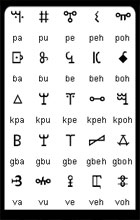 |
The Vai syllabary is a syllabic writing system devised for the Vai language by Momolu Duwalu Bukele of Jondu, in what is now Grand Cape Mount County, Liberia. Vai, like Amharic, is written Left-Right. From 1830s - present it is used in Liberia, especilly among Vai speakers. The syllabary proved popular with the Vai and by the end of the 19th century most of them were using it. In 1962 the Standardization Committee at the University of Liberia standardized the syllabary. A Vai version of the New Testament in the Vai script appeared in 2003.Notable features Type of writing system: syllabary Direction of writing: left to right in horizontal lines Each symbol represents a consonant plus a vowel Used to write Vai (ꕙꔤ), a member of Mande group of Niger-Congo languages spoken by about 104,000 people in Liberia, and by about 15,500 people in Sierra Leone. |
Vai Syllabary
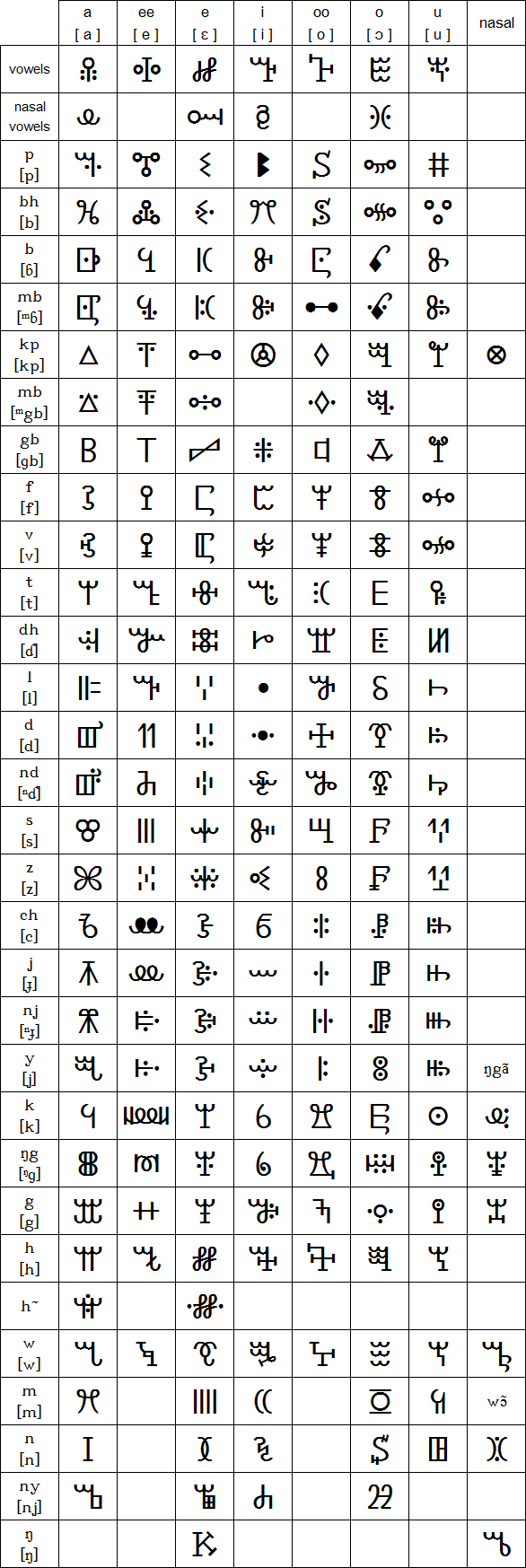
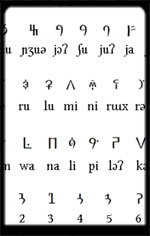 |
A-ka-u-ku
is a script invented by King Ibrahim Njoya, the 17th king of the Bamum
of West Cameroon, in 1896. It is classed in the Benue-Congo language
group, the largest branch of the Niger-Congo language family.
It
was made with the intention to preserve and transmit the history of
his people, as back then the only method of transmission was oral.
Ibrahim realised the inherent risk of mistelling, accidental or
deliberate, and thus during his reign ensured all levels of his
government and educational institutions learned and taught this script.
Named after its first 4 letters, A-ka-u-ku stands as relatively modern
proof that “Africa has always been an illiterate continent” is untrue.
|
However, due to tensions between the French government and Ibrahim
Njoya leading to his subsequent exile, it is no longer in general use
and most Bamum have forgotten it. His grandson, current sultan of
Cameroon Ibrahim Mbombo Njoya, has since transformed his palace into a
school to re-teach the Bamum this script. The sultan initiated The
Bamum Scripts and Archives Project in 2005 to bring it back from the
brink of extinction [1].
Symbols and ideograms are used to depict syllables, making it a syllabary rather than an alphabet (alphabets use characters that symbolise consonants and vowels separately. Syllabaries’ characters symbolise syllables, in which consonants and vowels are often conjoined) [2]. When he first developed it Ibrahim’s officials helped him to simplify it because it had 465 characters! In its finalised form, though, it had a much more manageable 70 characters and 10 numerals. Just like the English alphabet it is read from left to right [3].
(note: A-ka-u-ku is often confused with Shümom, an artificial spoken
language also of Ibrahim Njoya’s manufacture which came after the
script. This is, perhaps ironically, in much more widespread usage than
A-ka-u-ku).
[1] http://bamumscript.org/
[2] http://www.thefreedictionary.com/syllabary
[3] http://www.omniglot.com/writing/bamum.htm
[2] http://www.thefreedictionary.com/syllabary
[3] http://www.omniglot.com/writing/bamum.htm
Bangam Syllabary
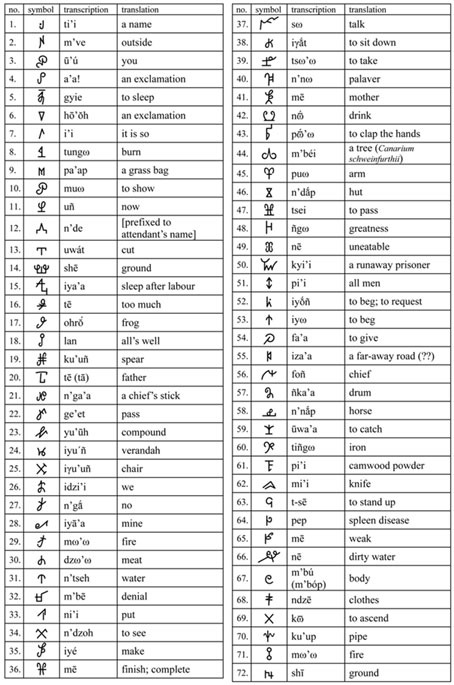
 |
Nsibidis is a system of symbols indigenous to what is now South Eastern Nigeria that is ideographic (a graphic symbol that represents an idea or concept), though there have been suggestions that it includes logographic elements (. The symbols are at least several centuries old: Early forms appeared on excavated pottery as well as what are most likely ceramic stools and headrests from the Calabar region, dating between 400 and 1400 CE. Nsibidi's origin is generally attributed to the Ekoi people of Southern Nigeria. Nsibidi (also known as nsibiri, nchibiddi or nchibiddy) is a system of symbols indigenous to what is now southeastern Nigeria that is apparently ideographic, though there have been suggestions that it includes logographicelements |
. The symbols are at
least several centuries old: Early forms appeared on excavated pottery
from the Calabarregion dating between 400 and 1400 CE. Nsibidi's origin
is generally attributed to the Ekoi people of southern Nigeria.
Alternatively J. K. Macgregor claimed in 1909 that it is traditionally
said to have come from the Uguakima, Ebe or Uyanga tribes of the Igbo
people, which legend says were taught the script by baboons, although
one writer believes Macgregor had been misled by his informants.
There are thousands of
nsibidi symbols, of which over 500 have been recorded. They were once
taught in a school to children. Many of the signs deal with love
affairs; those that deal with warfare and the sacred are kept
secret. Nsibidi is used on wall designs, calabashes, metals (such as
bronze), leaves, swords, and tattoos. It is primarily used by
theEkpe leopard secret society (also known as Ngbe or Egbo), which is
found across Cross River among the Ekoi, Efik, Igbo people, and related
peoples. Outside knowledge of nsibidi came in 1904 when T.D. Maxwell
noticed the symbols.Before the British colonisation of the area, nsibidi
was divided into a sacred version and a public, more decorative version
which could be used by women. Aspects of colonisation such as Western
education and Christian doctrine drastically reduced the number of
nsibidi-literate people, leaving the secret society members as some of
the last literate in the symbols.Nsibidi was and is still a means of
transmitting Ekpe symbolism. Nsibidi was transported
to Cuba and Haiti via the Atlantic slave trade, where it developed into
the anaforuana and veve symbols.
History
Nsibidi has a wide vocabulary
of signs usually imprinted on calabashes, brass ware, textiles, wood
sculptures, masquerade costumes, buildings and on human skin. Nsibidi
has been described as a "fluid system" of communication consisting of
hundreds of abstract and pictographic signs. Nsibidi was described in
the colonial era by P.A. Talbot as a "a kind of primitive secret
writing", Talbot explained that nsibidi was used for messages "cut or
painted on split palm stems". J.K. Macgregor's view was that "The use of
nsibidi is that of ordinary writing. I have in my possession a copy of
the record of a court case from a town of Enion [Enyong] taken down in
it, and every detail ... is most graphically described". Nsibidi crossed
ethnic lines and was a uniting factor among ethnic groups in the Cross
River region.
Origin
The origin of nsibidi is most
commonly attributed to the Ejagham people of the northern Cross River
region, mostly because colonial administrators found the largest and
most diverse nsibidi among them. Nsibidi spread throughout the region
over time and mixed with other cultures and art forms such as the
Igbo uli graphic design.
Source
Wikipedia
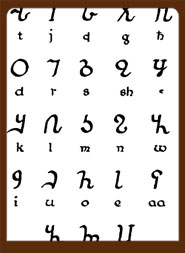 |
Osmanya,
also known as Cismaanya and far soomaali, is a Somalian script
invented between 1920 and 1922 by a man named Osman Yusuf Kenadid,
brother of the Sultan of Hobyo and a founding member of the Somali
Youth League. Osmanya’s purpose was to transcribe the Somali spoken
language (called Af-Soomaali), and though it became fairly widely used
it faced heavy competition from the Latin-based script and Arabic. Kenadid
invented this script in response to a national campaign calling for a
standardized orthography for the Somali language. Such a movement was
necessary because the Somali people’s ancient writing system had long
since been lost. |
Osmanya came
sufficiently widely accepted to replace Sheikh Uways’s Arabic-based
script. In the local schools of his Sultanate, news of the Osmanya
script spread quickly – so quickly the Italian authorities soon found
out and imprisoned Kenadid in Mogadishu. They feared he may arouse
nationalistic uprisings. Upon his arrest, Somalia’s calls for a
standardized script were silenced for the next 25 years.
After the end
of WW2 the Somali people were undergoing increasing nationalist
sentiments which, along with the invention of the Somali Youth League,
re-ignited interest in Osmanya and led to the independence of Somalia
from Italian & British rule. However in the 1960s Shire Jama Ahmed,
a Somali linguist, proposed a Latin-based script and presented it
before the Somali Language Committee. He competed against 17 other
prospective orthographies (including Osmanya, Arabic & some
Ge’ez-like scripts) to have his Latin-based script become the national
orthography. Despite this, the early 1970s saw Osmanya being used for
personal correspondence and bookkeeping purposes amongst the Somali
populace. Even some magazines and books had been published in
Osmanya Syllabary
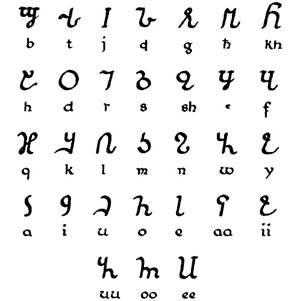 |
Osmanya as typewriters and other machines had been designed to accommodate its use.
However, in 1972 Mohamed Siad Barre, President at the time, unilaterally elected for Shire’s script to become the official standardized script of Af-Soomaali and then launched a literacy campaign to ensure it became the only one in use. Osmanya thus largely fell into disuse. |
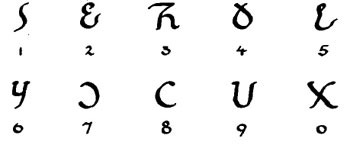 |
Just like English, Osmanya is written from left to right in horizontal rows. The names of the letters are very similar to those of Arabic letters, but they look completely different. |
Similar to Arabic, the
letters waw & ya (equivalent to w & y) are used as elongated
forms of the vowels u & i. Just like most ‘sub-Saharan’ African
languages Af-Soomaali is a tonal language, meaning tone/ pitch is used
to distinguish between words and different grammatical uses such as
gender, case & number. Though Osmanya doesn’t mark the 4 tones in
writing, it easily encompasses all the different sounds of Af-Soomaali.
The Zaghawa or Beria
alphabet, Beria Giray Erfe ('Zaghawa Writing Marks'), is an indigenous
alphabetic script proposed for the Zaghawa aka Beria language
of Darfur and Chad.
In the 1950s, a Sudanese
Zaghawa schoolteacher named Adam Tajir created an alphabet for the
Zaghawa language that was based on the clan brands used for livestock,
especially camels. Sometimes known as the camel alphabet, he copied the
inventory of the Arabic script, so the system was not ideal for Zaghawa.
Source
Wikipedia
The Mwangwego alphabet is an
abugida developed for Malawian languages by Nolence Mwangwego.[1] The
idea for a Malawian script came on November 10, 1977, in Paris, when he
discovered that there are various writing systems in the world, and
thought that words meaning "to write" in Malawian languages were
evidence that they once had a script of their own
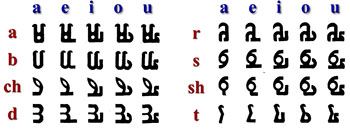
N'Ko alphabet
N'Ko is both a script devised
by Solomana Kante in 1949 as a writing system for the Manding languages
of West Africa, and the name of the literary language itself written in
the script. The term N'Ko means I say in all Manding languages. The
script has a few similarities to the Arabic script, notably its
direction (right-to-left) and the connected letters. It obligatorily
marks both tone and vowels.
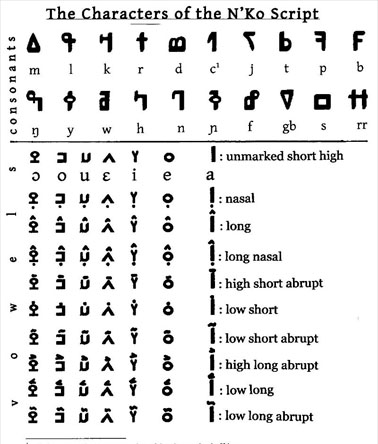
References
An
abugida (from Ge'ez አቡጊዳ 'äbugida), is a segmental writing system in
which consonant–vowel sequences are written as a unit: each unit is
based on a consonant letter, and vowel notation is secondary. This
contrasts with a "full alphabet", in which vowels have status equal to
consonants (e.g. In the word "book" both vowels and
constants are equal ( "b" and "o"), in Amharic, as in Hindi, the vowel
is attached as a secondary item to the constant), and with an abjad
script, in which vowel marking is absent or optional (Hebrew and
Arabic). In Arabic vowels are used for non-Arabic speakers who use
Arabic as a liturgy. True alphabet or not is not a statement of
superiority or evolved versus less evolved, they are just names for how
script mechanics operate.
Source: http://www.africanholocaust.net



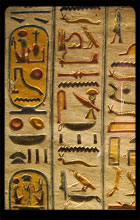
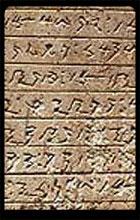
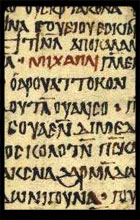
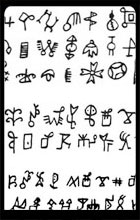
No comments:
Post a Comment